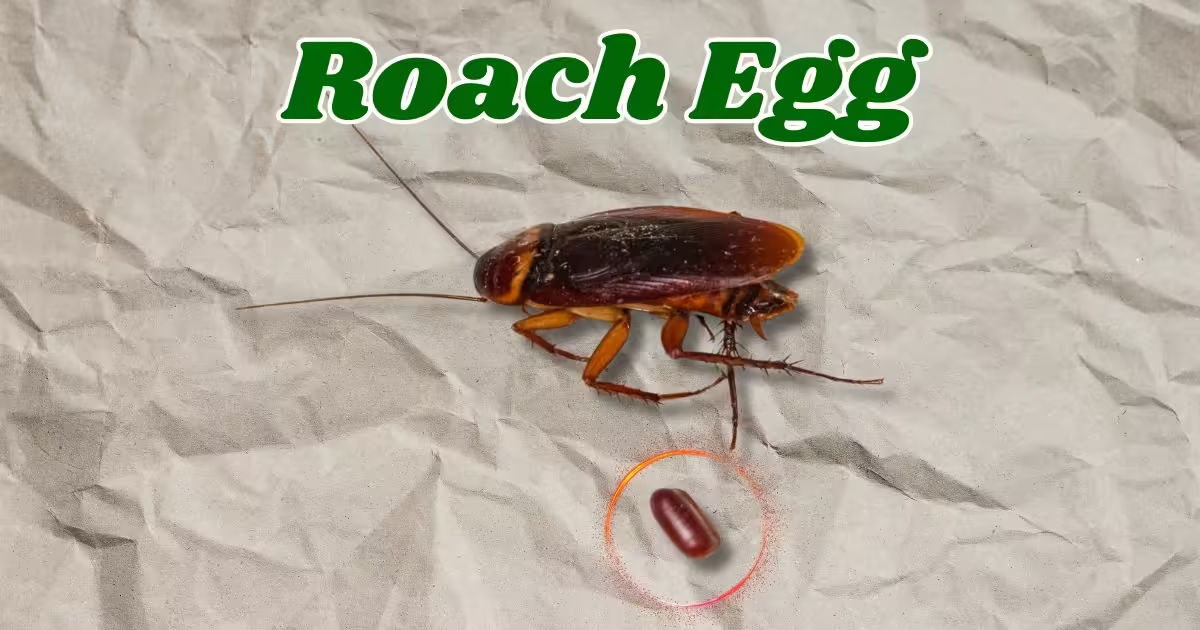If you’ve ever dealt with a cockroach infestation, you know how difficult it can be to fully eliminate these persistent pests. While many people focus on getting rid of adult cockroaches, one of the most critical steps in addressing an infestation is understanding and dealing with roach eggs. Roach eggs are often hidden in hard-to-reach places and can quickly lead to a new generation of cockroaches, making it essential to identify and remove them early.
In this article, we’ll explore 7 effective ways to identify and eliminate roach eggs, ensuring you protect your home from future infestations. From understanding where cockroaches lay their eggs to using proven removal techniques, this guide will provide everything you need to know about preventing a cockroach problem before it spirals out of control.
Let’s dive into the world of roach eggs and learn how you can safeguard your home from these unwelcome intruders.
1. What Is a Roach Egg? Understanding Cockroach Reproduction
A roach egg is a small, oval-shaped capsule that contains multiple cockroach embryos. Cockroaches reproduce by laying these eggs in a protective casing known as an ootheca, which can house anywhere from 16 to 50 eggs, depending on the species. This casing protects the eggs from environmental dangers and predators, making it more difficult for homeowners to eliminate an infestation.
Cockroach species, such as the German cockroach and American cockroach, have different reproductive cycles, but all rely on the creation of oothecae to ensure their species’ survival. For example, the German cockroach, one of the most common household pests, produces an ootheca with 30-50 eggs that hatch within 28 days. The American cockroach, on the other hand, lays an ootheca containing 16 eggs, which take around 6-8 weeks to hatch.
Once the eggs inside the ootheca hatch, nymphs emerge and begin their life cycle. Nymphs are smaller versions of adult cockroaches, and they go through several molting stages before reaching maturity. Without proper intervention, these nymphs grow into adult cockroaches capable of laying more eggs, thus continuing the infestation cycle.
Cockroaches strategically hide their eggs in protected, dark places that are difficult to reach, such as behind appliances, inside cracks in the walls, or under furniture. This is why identifying and addressing roach eggs is a crucial part of any pest control plan.
Understanding how cockroaches reproduce and where they hide their eggs will help you tackle an infestation at its source. In the next section, we’ll discuss how to identify roach eggs in your home and what signs to watch for.
2. How to Identify Roach Eggs: Key Signs to Watch For
Identifying roach eggs is the first step in preventing a full-blown cockroach infestation. While adult cockroaches are easier to spot, their eggs can be much harder to detect. Here are some key signs and characteristics to help you identify roach eggs:
1. Appearance of Roach Eggs
Roach eggs, or oothecae, are typically brown or reddish-brown in color and have a capsule-like shape. They are small—ranging from 5 to 10 millimeters in length, depending on the cockroach species. The ootheca has a smooth, shiny surface and may look like a tiny pill or seed.
2. Where to Look
Cockroaches often hide their eggs in dark, secluded areas. Common places to check for roach eggs include:
- Underneath kitchen appliances like stoves, refrigerators, and dishwashers.
- Cracks and crevices in walls, floors, and cabinets.
- Behind furniture or near baseboards.
- Inside pantries or storage areas where food is kept.
3. Egg Casings Left Behind
In some cases, you may find empty ootheca casings after the eggs have hatched. These casings are similar in appearance to the egg itself but may be slightly lighter in color and appear dry or brittle. If you spot these casings, it’s a sign that roaches have already hatched and are potentially spreading in your home.
4. Signs of Nymphs
After roach eggs hatch, the tiny nymphs emerge and can often be spotted crawling around dark areas. Nymphs are smaller and lighter in color than adult cockroaches, and their presence indicates that the eggs have recently hatched.
Knowing what to look for will help you locate roach eggs before they turn into a larger problem. In the next section, we’ll explore the lifecycle of roach eggs and how long it takes for them to hatch.
3. The Lifecycle of a Roach Egg: From Egg to Adult Cockroach
The lifecycle of a roach egg is an important factor to understand when addressing a cockroach infestation. Knowing how long it takes for an egg to hatch and develop into an adult can help you time your pest control efforts effectively.
1. Egg Stage
Cockroach eggs are encased in a protective capsule called an ootheca, which shields the embryos from environmental threats and predators. Depending on the species, each ootheca can contain between 16 to 50 eggs. The German cockroach produces more eggs per ootheca than other species, making it one of the most troublesome pests to deal with.
2. Hatching
The time it takes for roach eggs to hatch varies by species and environmental conditions, such as temperature and humidity. In general:
- German cockroach eggs hatch within 24-28 days.
- American cockroach eggs take longer, around 6-8 weeks to hatch.
Once the eggs hatch, nymphs emerge. Nymphs resemble smaller versions of adult cockroaches but are lighter in color and lack fully developed wings.
3. Nymph Stage
Nymphs go through several molting stages, during which they shed their outer layer (exoskeleton) and grow larger. It can take anywhere from a few weeks to several months for a nymph to mature into an adult, depending on the species and environmental factors.
4. Adult Stage
Once the nymphs reach maturity, they become adult cockroaches capable of laying their own eggs. Adult cockroaches can live anywhere from 6 months to 2 years, depending on the species and conditions. During their lifetime, female cockroaches can produce hundreds of offspring, leading to a rapidly growing infestation if not addressed.
Understanding the roach egg lifecycle can help you time pest control treatments to disrupt the cycle before eggs hatch and nymphs mature. Next, we’ll discuss how to effectively remove roach eggs from your home.
4. How to Get Rid of Roach Eggs: Proven Removal Techniques
Effectively removing roach eggs from your home is a crucial step in eliminating an infestation. While killing adult cockroaches is important, failure to address their eggs can lead to a resurgence of pests. Here are some proven techniques for getting rid of roach eggs:
1. Vacuuming
One of the easiest and most effective ways to remove roach eggs is by vacuuming. Use a vacuum with a strong suction to remove eggs from cracks, crevices, and hard-to-reach areas. Be sure to empty the vacuum bag or canister immediately into a sealed trash bag to prevent the eggs from hatching inside.
2. Boric Acid
Boric acid is a widely used insecticide that works well against both adult roaches and their eggs. Apply a thin layer of boric acid powder in areas where you’ve found roach eggs, such as under appliances, inside cabinets, or along baseboards. When cockroaches come into contact with boric acid, it disrupts their digestive and nervous systems, leading to death.
3. Insect Growth Regulators (IGRs)
Insect growth regulators (IGRs) are chemicals that prevent roach eggs from hatching and stop nymphs from maturing into adults. IGRs work by interfering with the insects’ hormonal systems, effectively breaking the lifecycle of cockroaches. These products can be found in sprays or baits and are a great addition to any pest control strategy.
4. Professional Pest Control
If you’re dealing with a large infestation, it may be best to call in professional pest control services. Pest control experts use specialized tools and chemicals to target roach eggs in hidden areas that are difficult to reach on your own.
By using these roach egg removal techniques, you can prevent a new generation of cockroaches from taking over your home. In the next section, we’ll discuss the signs of a roach egg infestation and what to watch for.
To truly keep your home roach-free, addressing the eggs is just as important as dealing with the adults. If you’re looking for more tips on managing baby roaches effectively, check out this guide on handling baby roaches to help prevent infestations from growing out of control.
5. Signs of a Roach Egg Infestation: What You Need to Know
Detecting the early signs of a roach egg infestation can help you take action before the problem escalates. Here are some common indicators that cockroaches may be laying eggs in your home:
1. Increased Cockroach Activity
If you’re noticing more cockroaches than usual, especially at night, it could be a sign that they are actively breeding and laying eggs. Cockroaches tend to come out at night, so if you see them during the day, it may indicate a large infestation that is forcing them out of their hiding spots.
2. Finding Oothecae
Spotting roach egg cases (oothecae) is a clear sign of a cockroach infestation. These egg cases are often hidden in dark, secluded areas, such as under appliances, in cracks, and behind furniture. If you find multiple oothecae, it’s a strong indication that the infestation is spreading.
3. Nymph Sightings
Seeing small, light-colored nymphs is another sign that roach eggs have recently hatched. Nymphs are smaller and more translucent than adult cockroaches but quickly grow as they molt. The presence of nymphs means that the infestation is in its early stages, and immediate action is needed.
4. Cockroach Droppings
Cockroach droppings are often found near egg-laying sites. The droppings look like small black specks or pellets and may accumulate in areas where cockroaches are nesting. If you notice droppings near hidden areas like cabinets, baseboards, or behind furniture, it’s a good sign that cockroaches are laying eggs nearby.
5. Unusual Odor
A strong, musty odor can be another indication of a cockroach infestation. As cockroaches breed and lay eggs, they release pheromones that can create an unpleasant smell. This odor becomes stronger as the infestation grows.
Recognizing these signs early can help you stop a roach egg infestation in its tracks. In the next section, we’ll cover how to prevent roach eggs from being laid in your home.
6. Preventing Roach Eggs in Your Home: Best Practices and Tips
Preventing cockroaches from laying roach eggs in your home is key to avoiding a larger infestation. Here are some best practices and tips to keep your home roach-free:
1. Keep Your Home Clean
Cockroaches are attracted to food and water sources, so keeping your home clean and dry is one of the most effective ways to prevent them from laying eggs. Regularly sweep and mop your floors, wipe down countertops, and avoid leaving dirty dishes in the sink. Additionally, store food in airtight containers and remove crumbs or spills promptly.
2. Seal Cracks and Gaps
Cockroaches often enter homes through small cracks and gaps in walls, floors, or windows. Inspect your home for potential entry points and seal them with caulk or weatherstripping. This will reduce the number of places where cockroaches can enter and lay their eggs.
3. Fix Leaks
Cockroaches need water to survive, and they often lay eggs near water sources. Fix any leaks in your plumbing, such as dripping faucets or pipes, to eliminate their access to moisture.
4. Use Roach Bait and Traps
Set up roach bait stations or sticky traps in areas where cockroaches are likely to lay eggs. These traps will help reduce the number of adult cockroaches and prevent them from reproducing.
5. Regular Pest Control Inspections
Having regular pest control inspections can help identify early signs of cockroach activity before they become a larger issue. Professional pest control services can treat your home with insecticides and growth regulators that stop cockroaches from laying eggs.
By following these prevention strategies, you can significantly reduce the likelihood of cockroaches laying roach eggs in your home, keeping infestations at bay.
7. Where Do Cockroaches Lay Eggs? Common Hiding Spots to Check
Cockroaches are notorious for hiding their eggs in secluded, hard-to-reach spots, making it difficult to find and eliminate them. Knowing where to look for roach eggs is essential for effective pest control. Here are some common hiding places to check:
1. Behind Appliances
Cockroaches often lay their eggs behind large kitchen appliances like refrigerators, stoves, and dishwashers. These areas are warm, dark, and provide easy access to food and water, making them ideal spots for cockroaches to nest and lay eggs.
2. Cracks and Crevices
Cockroaches prefer to hide their eggs in cracks and crevices in walls, floors, and cabinets. Check around baseboards, inside kitchen cabinets, and in any small openings where cockroaches can easily hide.
3. Under Furniture
Large, immobile pieces of furniture, such as sofas or beds, are perfect hiding spots for cockroach eggs. These areas provide protection and are often undisturbed, allowing the eggs to hatch in peace.
4. Inside Pantries
Since cockroaches are attracted to food, they may lay their eggs inside pantries or other food storage areas. Inspect any corners or cracks in your pantry for signs of oothecae, and store food in tightly sealed containers.
5. Bathrooms
Cockroaches are drawn to moisture, so bathrooms are another common location for egg-laying. Look for eggs behind the toilet, under the sink, or in the cracks of bathroom tiles.
By thoroughly inspecting these areas and removing any roach eggs you find, you can stop an infestation before it gets out of control. In the next section, we’ll wrap up with frequently asked questions and final tips for managing roach eggs.
FAQs About Roach Eggs
- How long do roach eggs take to hatch?
Roach eggs typically hatch within 24 to 28 days for German cockroaches and 6 to 8 weeks for American cockroaches. - What do roach eggs look like?
Roach eggs are usually small, brown, or reddish-brown capsules, about 5-10 millimeters in size. - Where do cockroaches hide their eggs?
Cockroaches hide their eggs in dark, hidden places, such as behind appliances, inside cracks, or under furniture. - Can roach eggs survive without a cockroach?
Yes, roach eggs can survive without the adult cockroach since they are protected by the ootheca casing. - How many eggs does a cockroach lay at once?
A single ootheca can contain anywhere from 16 to 50 eggs, depending on the cockroach species. - How do I get rid of roach eggs?
You can remove roach eggs by vacuuming, using boric acid, applying insect growth regulators (IGRs), or hiring a professional pest control service. - Do roach eggs spread diseases?
While roach eggs themselves don’t spread diseases, cockroaches can carry harmful bacteria that contaminate food and surfaces. - What should I do if I find roach eggs?
If you find roach eggs, immediately remove them using vacuuming or insecticides, and inspect the area for more signs of an infestation. - Can I use DIY methods to prevent roach eggs?
Yes, DIY pest control methods, such as keeping your home clean, sealing cracks, and using traps, can help prevent roaches from laying eggs. - How do I prevent cockroaches from laying eggs in my home?
Regular cleaning, sealing entry points, fixing leaks, and using roach bait are effective ways to prevent cockroaches from laying eggs.
Conclusion
Dealing with roach eggs is a critical step in eliminating a cockroach infestation. By learning how to identify roach eggs, understanding their lifecycle, and using proven removal techniques, you can stop these pests before they multiply and overrun your home. From vacuuming and using boric acid to adopting preventive measures like sealing cracks and keeping your home clean, there are several strategies to control and prevent cockroach egg infestations.
By taking proactive steps to address roach eggs, you can protect your home from the health risks and nuisance that cockroaches bring. Remember, addressing both adult roaches and their eggs is key to successfully eradicating an infestation and keeping your living space pest-free.
If you notice any signs of a roach infestation, act quickly to eliminate both the adults and their eggs, ensuring that your home remains a safe, clean environment for you and your family.

Joseph Bush is a seasoned writer and researcher with over 7 years of experience covering a wide range of general topics, from lifestyle and technology to business and current events. He is dedicated to producing fact-checked, reader-friendly content that informs, engages, and empowers readers.
Throughout his career, Joseph has followed strict editorial guidelines, relied on reputable sources, and ensured every article meets the highest standards of accuracy and clarity. His expertise spans multiple fields, allowing him to explain complex topics in a way that’s easy to understand.
Passionate about continuous learning, Joseph stays updated on industry trends and best practices to deliver trustworthy, well-rounded insights. Readers can rely on his work for its credibility, depth, and real-world relevance.




